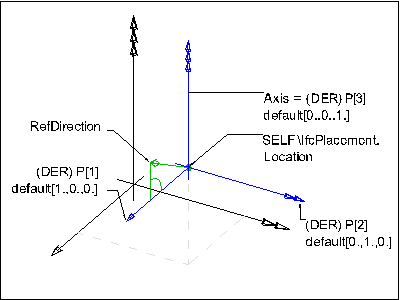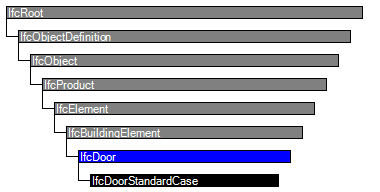IfcAxis2Placement3D IFC构件的位置和方向
IfcAxis2Placement3D定义了三维空间中物体的位置和方向,由三部分组成:
The attribute Axis defines the Z direction, RefDirection the X direction. The Y direction is derived.
注:Y轴方向由X轴和Z轴方向通过外积计算获得。
当Axis和RefDirection未定义时,X轴为P[1] ,默认值 [1.,0.,0.]。Y轴为P[2],默认值为[0.,1.,0.]。Z轴为P[3] ,默认值为[0.,0.,1.]。

属性定义
| # | Attribute | Type | Cardinality | Description | C |
|---|---|---|---|---|---|
| 2 | Axis | IfcDirection | [0:1] | The exact direction of the local Z Axis. | X |
| 3 | RefDirection | IfcDirection | [0:1] | The direction used to determine the direction of the local X Axis. If necessary an adjustment is made to maintain orthogonality to the Axis direction. If Axis and/or RefDirection is omitted, these directions are taken from the geometric coordinate system. | X |
| P :=IfcBuildAxes(Axis, RefDirection) |
IfcDirection | L[3:3] | The normalized directions of the placement X Axis (P[1]) and the placement Y Axis (P[2]) and the placement Z Axis (P[3]). | X |
| Rule | Description |
|---|---|
| LocationIs3D | The dimensionality of the placement location shall be 3. |
| AxisIs3D | The Axis when given should only reference a three-dimensional IfcDirection. |
| RefDirIs3D | The RefDirection when given should only reference a three-dimensional IfcDirection. |
| AxisToRefDirPosition | The Axis and RefDirection shall not be parallel or anti-parallel. |
| AxisAndRefDirProvision | Either both, Axis and RefDirection are not given and therefore defaulted, or both shall be given. |
继承关系:

属性
| # | Attribute | Type | Cardinality | Description | C |
|---|---|---|---|---|---|
| IfcRepresentationItem | |||||
| LayerAssignment | IfcPresentationLayerAssignment @AssignedItems |
S[0:1] | Assignment of the representation item to a single or multiple layer(s). The LayerAssignments can override a LayerAssignments of the IfcRepresentation it is used within the list of Items. | X | |
| StyledByItem | IfcStyledItem @Item |
S[0:1] | Reference to the IfcStyledItem that provides presentation information to the representation, e.g. a curve style, including colour and thickness to a geometric curve. | X | |
| IfcGeometricRepresentationItem | |||||
| IfcPlacement | |||||
| 1 | Location | IfcCartesianPoint | [1:1] | The geometric position of a reference point, such as the center of a circle, of the item to be located. | X |
| Dim :=Location.Dim |
IfcDimensionCount | [1:1] | The space dimensionality of this class, derived from the dimensionality of the location. | X | |
| IfcAxis2Placement3D | |||||
| 2 | Axis | IfcDirection | [0:1] | The exact direction of the local Z Axis. | X |
| 3 | RefDirection | IfcDirection | [0:1] | The direction used to determine the direction of the local X Axis. If necessary an adjustment is made to maintain orthogonality to the Axis direction. If Axis and/or RefDirection is omitted, these directions are taken from the geometric coordinate system. | X |
| P :=IfcBuildAxes(Axis, RefDirection) |
IfcDirection | L[3:3] | The normalized directions of the placement X Axis (P[1]) and the placement Y Axis (P[2]) and the placement Z Axis (P[3]). | X | |
ENTITY IfcAxis2Placement3D SUBTYPE OF (IfcPlacement); Axis : OPTIONAL IfcDirection; RefDirection : OPTIONAL IfcDirection; DERIVE P : LIST [3:3] OF IfcDirection := IfcBuildAxes(Axis, RefDirection); WHERE LocationIs3D : SELF\IfcPlacement.Location.Dim = 3; AxisIs3D : (NOT (EXISTS (Axis))) OR (Axis.Dim = 3); RefDirIs3D : (NOT (EXISTS (RefDirection))) OR (RefDirection.Dim = 3); AxisToRefDirPosition : (NOT (EXISTS (Axis))) OR (NOT (EXISTS (RefDirection))) OR (IfcCrossProduct(Axis,RefDirection).Magnitude > 0.0); AxisAndRefDirProvision : NOT ((EXISTS (Axis)) XOR (EXISTS (RefDirection))); END_ENTITY;
DATA; #1= IFCORGANIZATION($,'Autodesk Revit 2015 (CHS)',$,$,$); #5= IFCAPPLICATION(#1,'2015','Autodesk Revit 2015 (CHS)','Revit'); #6= IFCCARTESIANPOINT((0.,0.,0.)); #9= IFCCARTESIANPOINT((0.,0.)); #11= IFCDIRECTION((1.,0.,0.)); #13= IFCDIRECTION((-1.,0.,0.)); #15= IFCDIRECTION((0.,1.,0.)); #17= IFCDIRECTION((0.,-1.,0.)); #19= IFCDIRECTION((0.,0.,1.)); #21= IFCDIRECTION((0.,0.,-1.)); #23= IFCDIRECTION((1.,0.)); #25= IFCDIRECTION((-1.,0.)); #27= IFCDIRECTION((0.,1.)); #29= IFCDIRECTION((0.,-1.)); #31= IFCAXIS2PLACEMENT3D(#6,$,$); #15794= IFCAXIS2PLACEMENT3D(#6,$,$); #15795= IFCLOCALPLACEMENT($,#15794); #32= IFCLOCALPLACEMENT(#15795,#31); #117= IFCAXIS2PLACEMENT3D(#6,$,$); #118= IFCLOCALPLACEMENT(#32,#117); #803= IFCCARTESIANTRANSFORMATIONOPERATOR3D($,$,#6,1.,$); #684= IFCSHAPEREPRESENTATION(#88,'Body','SweptSolid',(#674)); #686= IFCAXIS2PLACEMENT3D(#6,$,$); #687= IFCREPRESENTATIONMAP(#686,#684); #1255= IFCMAPPEDITEM(#687,#803); #1256= IFCSHAPEREPRESENTATION(#88,'Body','MappedRepresentation',(#1255)); #1258= IFCPRODUCTDEFINITIONSHAPE($,$,(#1256)); #1260= IFCCARTESIANPOINT((1325.86888709244,31631.0676658748,0.)); #1262= IFCAXIS2PLACEMENT3D(#1260,$,$); #1263= IFCLOCALPLACEMENT(#118,#1262); #1264= IFCCOLUMN('2ILfSTle57UhpKxVJ8Mj7L',#41,'\X2\7EFC5408697C\X0\-\X2\6DF751DD571F77E95F6267F1\X0\:450 x 600 mm:365232',$,'450 x 600 mm',#1263,#1258,'365232');
计算构件y轴方向
#1 = IfcDirection((0.,0.,1.)); //z轴 #2 = IfcDirection((1.,0.,1.)); //x轴 #3 = IfcAxis2Placement3D($,#1,#2); //叉积计算出y轴 (0 ,1, 0) #4 = IfcLocalPlacement($,#3); #5 = IfcDirection((0.,1.,0.)); //z轴 #6 = IfcDirection((1.,0.,1.)); //x轴 #7 = IfcAxis2Placement3D($,#5,#6); //叉积计算出y轴(1, 0, -1) #8 = IfcLocalPlacement(#4,#7); //矩阵相乘(注意顺序)结果:x轴(0,0,1)y轴(1,0,0)z轴(0,1,0)
向量叉积计算
#include <iostream> using namespace std; struct Vec { double x; double y; double z; }; Vec ThreeCross(const Vec& a, const Vec& b) { Vec C; C.x = a.y * b.z - a.z * b.y; C.y = a.z * b.x - a.x * b.z; C.z = a.x * b.y - a.y * b.x; return C; } int main() { Vec v1; v1.x = 0; v1.y = 0; v1.z = 1; Vec v2; v2.x = 1; v2.y = 0; v2.z = 1; Vec v3 = ThreeCross(v1,v2); cout << v3.x << " " << v3.y << " " << v3.z << endl; system("pause"); return 0; }
向量叉积计算公式:
a=(X1,Y1,Z1),b=(X2,Y2,Z2),
a×b=(Y1Z2 - Y2Z1,Z1X2 - Z2X1,X1Y2 - X2Y1)
V1(1,2,3)
V2(4,5,6)
V1 * V2=(12-15,12-6,5-8)=(-3,6,-3)

参考:https://blog.csdn.net/liyazhen2011/article/details/82347074
QQ 3087438119




 浙公网安备 33010602011771号
浙公网安备 33010602011771号